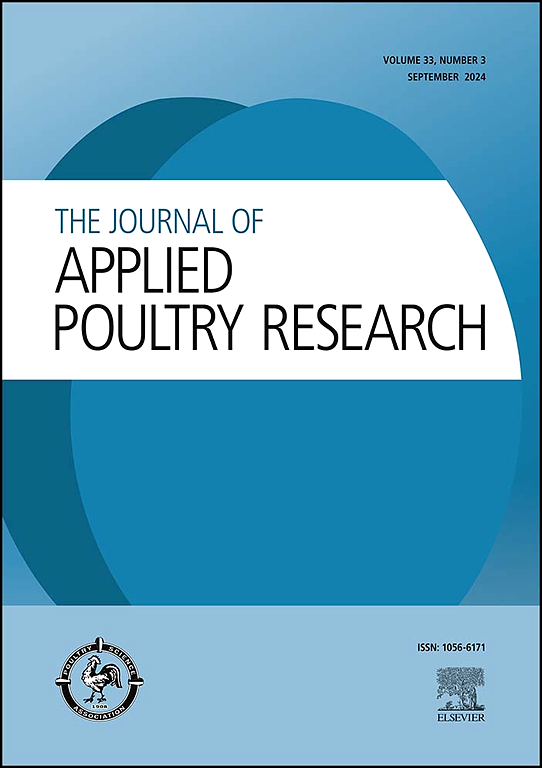Assessing dried black soldier fly larva as a feed component for poultry production
IF 2
3区 农林科学
Q2 AGRICULTURE, DAIRY & ANIMAL SCIENCE
引用次数: 0
Abstract
The objectives of this research were to determine the nitrogen corrected true metabolizable energy (TMEn), and digestible amino acid content of dried black soldier fly larva (BSFL), to determine if the methionine and lysine content of BSFL could be enriched by adding more crystalline lysine and methionine to their diet, and to determine if BSFL could be incorporated into broiler diets without compromising bird performance. Cecectomized and intact adult Single Comb White Leghorn roosters were used to determine amino acids digestibility and TMEn values, respectively on 8 BSFL samples from different sources. Broilers were fed from 0 to 21 d of age diets containing 0, 6, or 12 % BSFL in one experiment and 0, 6, 12, and 16 % in another experiment. The TMEN values on an as is basis ranged from 3,611 to 5,142 kcal/kg. Essential amino acid digestibility coefficient values ranged from 73 to 97 %. Growing BSFL on a nutritionally complete broiler finisher diet supplemented with extra crystalline lysine and methionine resulted in them having a significant, but marginal increase in the content of these amino acids relative to those reared on the control diet. Broilers fed diets containing 16 % BSFL had a decreased body weight gain and an increased feed to gain ratio relative to those fed the other treatments. The results indicate that as the production of BSFL is standardized yielding more consistent nutrient content, it could be suitable to be incorporated into broiler diets at least 6 % without negatively impacting bird performance.
干黑虻幼虫作为家禽饲料成分的评价
本研究旨在测定干黑兵蝇幼虫(BSFL)的氮校正真代谢能(TMEn)和可消化氨基酸含量,确定在其饲粮中添加更多的晶体赖氨酸和蛋氨酸是否可以提高干黑兵蝇幼虫的蛋氨酸和赖氨酸含量,并确定在不影响鸟类生产性能的情况下,将干黑兵蝇添加到肉仔鸡饲粮中是否可行。采用切除盲肠和完整的成年单梳白来角公鸡,分别测定8种不同来源的BSFL样品的氨基酸消化率和TMEn值。0 ~ 21日龄分别饲喂含0、6、12% BSFL和0、6、12、16% BSFL的饲粮。TMEN值在不变的基础上从3,611到5,142千卡/公斤。必需氨基酸消化系数为73% ~ 97%。在营养完全肉鸡育肥猪饲粮中添加额外的结晶赖氨酸和蛋氨酸,可显著提高这些氨基酸的含量,但与对照组饲粮相比,这些氨基酸的含量略有增加。饲粮中添加16% BSFL的肉鸡增重降低,料重比高于其他处理。综上所述,由于BSFL的生产是标准化的,因此其营养成分含量较为一致,在不影响肉鸡生产性能的情况下,在肉鸡饲粮中添加至少6%的BSFL是合适的。
本文章由计算机程序翻译,如有差异,请以英文原文为准。
求助全文
约1分钟内获得全文
求助全文
来源期刊

Journal of Applied Poultry Research
农林科学-奶制品与动物科学
CiteScore
4.10
自引率
10.50%
发文量
80
审稿时长
104 days
期刊介绍:
The Journal of Applied Poultry Research (JAPR) publishes original research reports, field reports, and reviews on breeding, hatching, health and disease, layer management, meat bird processing and products, meat bird management, microbiology, food safety, nutrition, environment, sanitation, welfare, and economics. As of January 2020, JAPR will become an Open Access journal with no subscription charges, meaning authors who publish here can make their research immediately, permanently, and freely accessible worldwide while retaining copyright to their work. Papers submitted for publication after October 1, 2019 will be published as Open Access papers.
The readers of JAPR are in education, extension, industry, and government, including research, teaching, administration, veterinary medicine, management, production, quality assurance, product development, and technical services. Nutritionists, breeder flock supervisors, production managers, microbiologists, laboratory personnel, food safety and sanitation managers, poultry processing managers, feed manufacturers, and egg producers use JAPR to keep up with current applied poultry research.
 求助内容:
求助内容: 应助结果提醒方式:
应助结果提醒方式:


